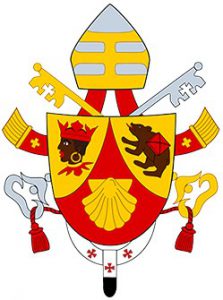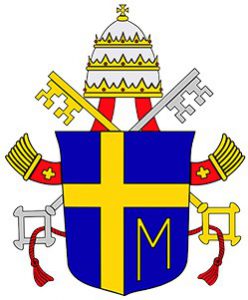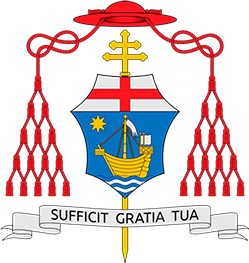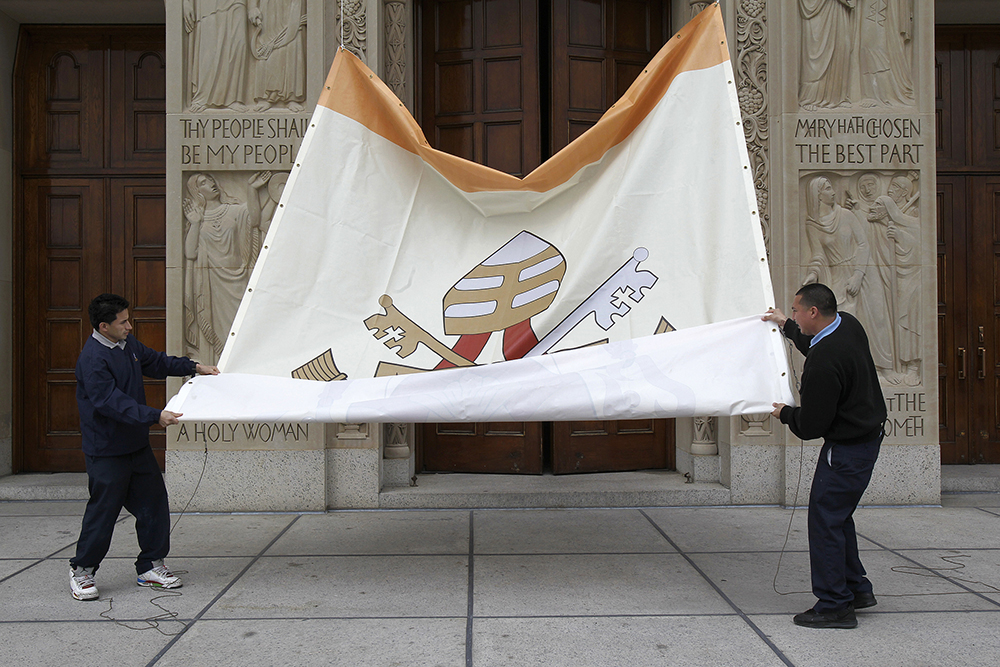Ecclesiastical heraldry is both familiar and mysterious.
Frequently seen in one form or another, coats of arms pervade our Catholic culture in numerous ways: on letters and newspapers, diocesan websites and Twitter pages, in Roman churches and diocesan cathedrals. Most Catholics, though, are unaware of the significance of this time-honored practice.
Steeped in tradition, ecclesiastical heraldry is a regulated system of self-identification, adopted by the Church from medieval society, which operates as a science and an art form with its own rules and regulations.
A heraldic achievement, also called a coat of arms, is permitted lawfully for those who occupy ecclesiastical office — for example, popes, cardinals, archbishops, bishops, monsignors, priests, religious superiors such as abbots and abbesses — as well as ecclesiastical territories and institutions — for example, dioceses, religious orders, papal knighthoods, basilicas, cathedrals, parish churches, schools and other Catholic institutions. While heraldry runs the risk of being seen as haughty or pompous, in reality it simply seeks to graphically herald (or announce) — in color and symbol — who and what the bearer is.
Identification
The use of artistic elements to identify personages, locations and possessions first existed in pre-Christian societies. Pharaohs of ancient Egypt offer one of the earliest precursors of heraldic practices. Their various holdings of goods and properties were identified with the symbols found in the cartouche, an oval symbol containing personal hieroglyphics with a distinct line at the bottom indicating royalty. Likewise, the Book of Numbers provides evidence that standards and symbols were used by the tribes of the nomadic Israelites in early biblical times (see 1:2,18,52).

The papal coat of arms of Pope Benedict XVI (2005-2013). Shutterstock
Modern heraldry finds its origins with the Battle of Hastings in 1066 — illustrated in the famous Bayeux Tapestry — when knights concealed by battle armor were first identified with decorated shields. Later developments incorporated the shield design into body coats, banners and even coverings for horses. These coats of arms subsequently became synonymous with the knight’s family, especially following the Third Crusade (1189-92). The shape and character of ecclesiastical heraldry are closely tied to these developments since the Church adopted many of the customs and traditions of the culture.
As feudal and belligerent Europe shifted into the structures of nobility and royalty, familial arms were used much as in ancient Egypt — to identify themselves and their possessions. Similar measures of personal identification were incorporated into items such as seals (often part of rings), which were legally mandated for use on documents and letters as a means to provide authenticity and prevent forgery.
Because noble status and property was inherited by the oldest son through primogeniture, the youngest son was typically offered for service in the Church. Familial arms continued to be used by those appointed to such ecclesiastical positions of jurisdiction and authority, although they were typically modified for ecclesiastical use by removing warlike symbols. Many sources indicate that the first bishop known to do so was Guy of Vergy, bishop of Autun in the early 13th century. A personal papal coat of arms — other than just the standard tiara and keys indicative of papal office — was first used during the pontificate of Pope Martin V (1417-31). Use of heraldry by all ecclesiastical officeholders became a standardized means of self-identification beginning in the 17th century.
Heraldry’s Rules
Because a coat of arms seeks to identify its bearer, each must be unique — like a passport or Social Security number. Therefore, offices and methods for documentation and legislation for both secular and ecclesiastical heraldry were established, the most notable and enduring secular example being the College of Arms established in England by King Richard III in 1484. Initial codification of heraldry in the Church coincided with widespread practice by the 17th century through a system of ecclesiastical headgear developed by French heraldist and printer Pierre Palliot.
Although the jurisprudence of secular heraldry significantly weighs upon the Church’s heraldic tradition, it was also shaped by the development of doctrinal, liturgical and canonical factors. The Church itself began to systematically regulate her heraldry in 1905, with Pope St. Pius X’s establishment of the Heraldry Commission of the Roman Curia, an office abolished in 1960 by Pope St. John XXIII.

The papal coat of arms of Pope St. John Paul II (1978-2005). He was the last pope to adopt the triple tiara of the popes. Shutterstock
At the end of the subsequent decade, with the approval of Pope Paul VI, three specialists published Rubrica Araldica Vaticana — the compendium of rules governing ecclesiastical heraldry today. Likewise, the Vatican Secretariat of State issued Ut sive sollicite in 1969, a brief instruction on coats of arms and other honorifics for cardinals, bishops and other prelates. Current scholarly interest in the field is reinforced by the laudable and exhaustive 2014 manual of ecclesiastical heraldry published by Cardinal Andrea Cordero Lanza di Montezemolo, a leading heraldic authority and designer of Pope Emeritus Benedict XVI’s coat of arms.
An equally significant aspect of heraldry’s regulations is the centuries’ old linguistic components governing it. In effect, heraldry has its own language.
Even today, the artistic rendering of a coat of arms is accompanied by a lengthy explanation written in blazon — heraldry’s own language. Coming from a word from French for “shield,” blazon combines terms of Old English and French resulting in a language with a distinctive word order, vocabulary and grammar. Blazon describes a coat of arms with such detail that it is possible to be artistically reproduced by anyone familiar with the lexicon. Coats of arms are described in Latin from the bearer’s point of view, left and right for the viewer correspondingly are called dexter and sinister.
A coat of arms for each ecclesiastical order, office, rank or institution contains several symbolic elements. External elements to the coat of arms describe what office and jurisdiction the bearer holds, while interior elements describe the bearer.
Starting at the uppermost part, replacing the knight’s helmet or monarch’s crown on the crest of secular arms, most ecclesiastical arms are topped with a galero — a hat now only used in ceremonial depictions.
The unique and central part of any coat of arms is the shield. Most shields for cardinals and bishops are impaled — a combination of two parts often indicating occupation of an office — in which the arms of the bearer’s diocese are seen on the left and personal arms are on the right. Examples of those bearing only their personal arms are titular bishops such as auxiliaries, some cardinals and officials in the Roman Curia or cardinals not ordained as bishops. Behind a bishop’s shield is a processional cross denoting rank in the episcopate: one horizontal bar indicates a bishop or two indicates an archbishop. The cross is replaced by a crosier for those with ordinary jurisdiction who are not bishops, such as abbots or the ordinaries of the Anglican Ordinariates. Because they occupy positions of jurisdiction, male and female religious superiors are entitled to bear a coat of arms, although the only one of those which might be impaled is an abbot’s with the arms of his abbey.

The coat of arms of Cardinal Angelo Scola, Archbishop of Milan since 2012, and previously the Patriarch of Venice. Shutterstock
A quick glance at a coat of arms, then, provides important information. Looking at the coat of arms of Cardinal Angelo Scola depicted on Page 28, the following facts about him can be deduced by reading his coat of arms: The coat of arms is topped with a red galero, indicating he is a cardinal; there is a processional cross with two horizontal bars, indicating he is a metropolitan archbishop; there is an impaled shield, indicating he is the ordinary bishop of his archdiocese.
Personal aspects of a shield also incorporate elements of the bearer’s life, often depicting symbols representative of their particular devotions or patron saints, life events or genealogy. Additionally, below the shield is a motto chosen by the bearer, typically from Scripture.
Michael R. Heinlein is editor of Simply Catholic. Follow him on Twitter @HeinleinMichael.

